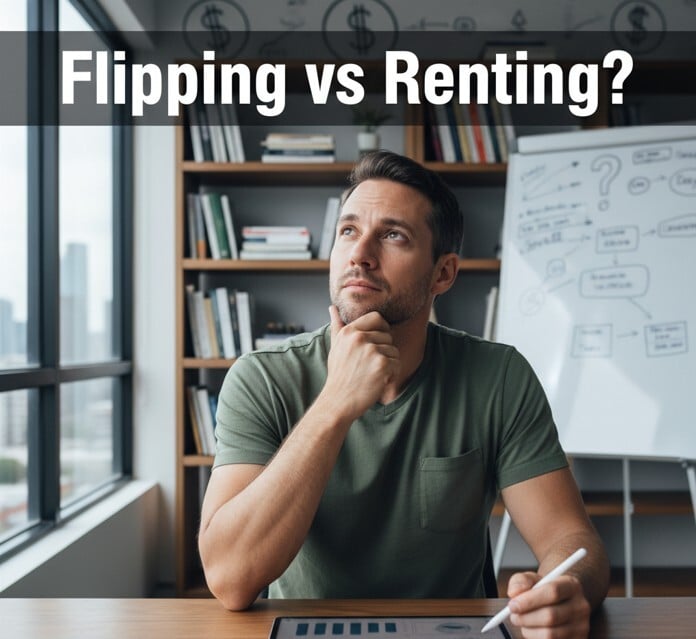How to Invest $10K in Real Estate (6 Ways)
Do you have some funds set aside to invest? Whether $10,000 or $100,000, real estate is one of the best places to park your money and build wealth...
6 min read
Rent To Retirement : Oct 21, 2025 7:22:53 AM

Want to build wealth through real estate? There are several ways for you to achieve this, with flipping and renting being two of the most popular options. In this article, we’ll compare these strategies and discuss their pros and cons so you can choose the one that best aligns with your long-term goals. Keep reading!
Summary:
Flipping and renting can both be profitable real estate investment strategies. The right choice for you will largely depend on your long-term goals, risk tolerance, experience, and the amount of time you have available to dedicate to your investments. Each strategy offers unique advantages and trade-offs: flipping requires active involvement and strong project management skills, while renting calls for more patience and a long-term approach.
Flipping provides large payouts when done right, but each project only pays once. With rentals, properties deliver ongoing passive income in smaller and more predictable amounts.
Investors can make upwards of $40,000 per flip, but since most flip profits are considered “short-term capital gains,” they get taxed at your marginal tax rate. Rental properties, on the other hand, get much better tax treatment, thanks to depreciation, interest deductions, and expense write-offs.
Flipping houses is extremely hands-on and may require as much time as a regular nine-to-five job. On the other hand, rental properties can be much more passive, requiring only a few hours each week—or even less if you have a property manager handling your property’s day-to-day.
Put just 5% down on your first (or next) investment property with Rent to Retirement!
Is house flipping the right strategy for you? Here’s what you need to know about flipping before getting started:
Flipping is the process of buying, renovating, and selling a property for profit. This strategy can provide fast and sizable returns, but it is considered high-risk and requires large amounts of time and capital.
House flipping isn’t the most beginner-friendly strategy. Not only are there significant investing risks involved, but specific skills and resources are also needed for a successful flip. Some experience as a contractor, agent, or investor can go a long way toward your success. You’ll need to know how much houses and renovations cost, the kind of return you can achieve, and how to manage a team for your rehab project.
Flipping is extremely hands-on and can even require as much time as a regular full-time job. If you don’t have the time or experience to do your own renovations, you’ll need to have quality contractors you can rely on.
Flipping can provide fast returns, but a single flip won’t make you rich. What’s more, you’re unlikely to come across many flippable homes on Zillow or Redfin. Instead, you’ll need other ways of finding investment properties that are underpriced—like sending letters, cold-calling owners, and communicating direct-to-seller.
Many investors prefer to own rental properties rather than flip houses. Here’s what you need to know about the strategy:
Renting is the process of buying and holding an investment property and leasing it out to tenants. This strategy provides not only monthly rental income but also appreciation as the home’s value increases over time.
A rental property can provide you with a long-term passive (or at least semi-passive) income stream. This type of investment can be especially valuable in retirement, when you might need consistent cash flow that doesn’t require a ton of work!
If your goal is to build long-term wealth, then rental properties are a great investment. While these properties won’t help you earn a quick buck, they can deliver consistent monthly cash flow, long-term appreciation, and massive tax benefits.
Do you want an investment and not another job? Fortunately, rental properties might only require a few hours of your time each week. Better yet, if you hire a property manager or buy turnkey rentals—recently built or renovated properties with property management already in place—you’ll spend even less time on your properties!
Start building headache-free wealth with turnkey rental properties!
Flipping is a high-risk, high-reward investing strategy. Here are some of the biggest benefits and drawbacks to keep in mind:
Want bigger returns and no tenants? Many investors choose to flip houses because of the following:
Flipping isn’t for everyone, as it involves significant risks and challenges:
Rental property investing is the most common way to invest in real estate, but you should carefully weigh the pros and cons before getting started:
Rentals are some of the best real estate investments, as they offer the following:
Invest in cash-flowing turnkey rentals with JUST 5% down!
Buying rentals can be a profitable long-term investing strategy, but there are a couple of drawbacks to keep in mind:
Want a combination of short-term profits, consistent monthly cash flow, and long-term gains? If you have the time and money to do so, you could flip houses and buy rental properties. One of the best ways to do this is to put a portion of your flip profits into rental properties. This way, you’re building long-term, sustainable, passive income while still maximizing your disposable income through house flipping!
While flipping can be a risky venture, especially for an inexperienced investor, rental properties have a much lower barrier to entry. What’s more, if you buy a turnkey property, you’ll likely have very little maintenance and tenant issues to deal with—especially since these properties come with property management and tenants already in place when you close!
Flipping is considered one of the riskier and more difficult real estate investing strategies. You’ll need not only plenty of free time but also money, resources, connections, and experience!
Yes, flipping houses can be a very lucrative strategy for an experienced real estate investor. Completing multiple flips per year could even generate enough income to replace your W-2 job!
The 70% rule is a guideline many investors use when analyzing properties to flip. It states that you should offer no more than 70% of a property’s after-repair value (ARV), minus any renovation costs. For example, if you’re buying a property that should appraise for $250,000 and requires $50,000 in renovations, your offer shouldn’t exceed $125,000 ($250,000 x .7 - $50,000).

Do you have some funds set aside to invest? Whether $10,000 or $100,000, real estate is one of the best places to park your money and build wealth...

Are you looking to work with a turnkey provider for your next rental property? MartelTurnkey is a company that you might come across during your...

Turnkey rentals are among the best real estate investments, whether you’re looking for a beginner-friendly investing strategy or aiming to add...